SOME MARCH MADNESS MOUNTAIN STYLE–
CORNBREAD RECOLLECTIONS AND FRIED PIE CRAVINGS
Lately I’ve been doing quite a bit of rummaging around in the vaults of my memory on food-related subjects. That is in part the result of writing connected with culinary matters (I have been doing a food piece for Smoky Mountain Living for a number of issues), a product of the fact I enjoy experimenting and reminiscing in the kitchen, and because I revel in looking back with longing to a world which seems to be vanishing like dandelion seeds in a spring breeze. Over time it has gradually dawned on me that a goodly portion of my food memories focus squarely on cornbread. With that in mind plus the sensory impact from the smell of a pone baking in the oven right now, it seems appropriate to share some cornbread recollections and cravings.
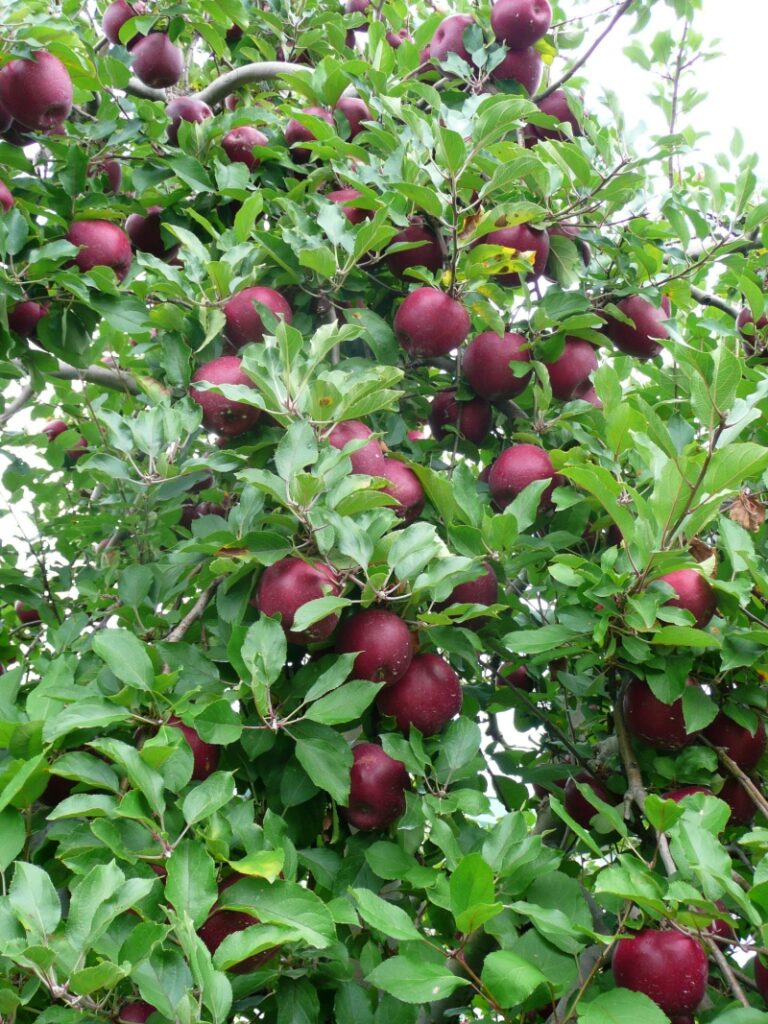
Perhaps the logical beginning point is to note that during my youth cornbread was as central to daily life as any foodstuff. I’ve got strong memories of hog-killing time, certain favorite items such as Momma’s fried chicken on Sundays and her cobblers, and special treats we only enjoyed on rare occasions. But when it comes to regularity of appearance on the menu, perhaps the only thing which rivaled cornbread was apples. Thanks to having a tiny orchard we ate apples in a myriad of ways—fried pies, deep-dish pies, cobblers, apple butter, jelly, applesauce cake, stack cake, and most of all simply as what we called “fruit” (stewed apples). Similarly, when it came to meat we ate more pork than anything else, although in their respective seasons squirrel, rabbit, and trout all took a place of pride on the family table.
Cornbread didn’t get much recognition or stir much excitement when Momma or Grandma Minnie answered the inevitable “What’s for dinner?” (dinner was our name for lunch, and it was the day’s main meal). It was just a staple, something you took for granted, ate with relish, and counted on day in and day out. Here are some of the ways we ate it and there were many more.
*Pones of cornbread. Baked in a cast-iron skillet, this was far and away the most common method of preparation. Typically a hot pone would be part of dinner and leftovers set aside to be eaten as an afternoon snack (one of my favorite grab-and-go meals for post school squirrel hunting forays was a big slice of cornbread and a raw turnip or raw onion) or at supper.
*Cornbread at supper was often crumbled into a big glass and either sweet milk or buttermilk poured over it. Another alternative was to open up a slice and insert a piece of fried streaked meat.
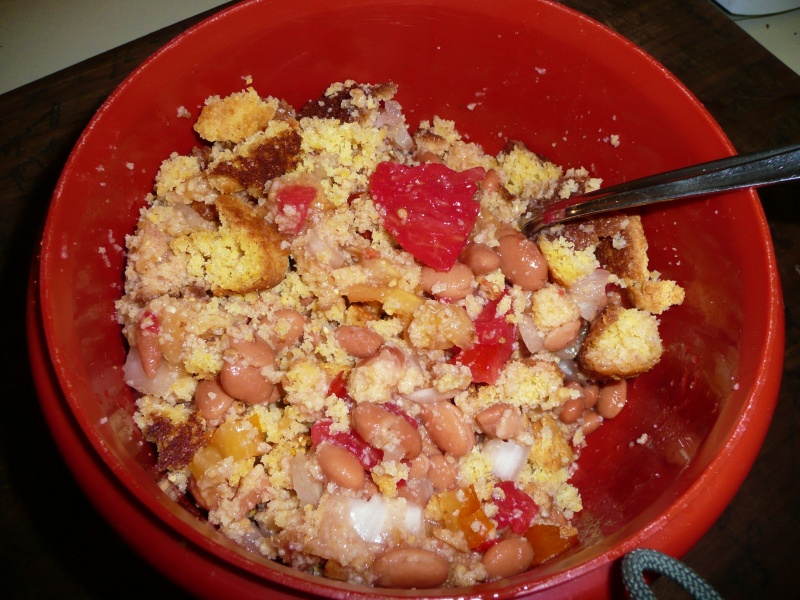
*One cornbread dish I did not experience as a youngster but love now is cornbread salad. This is a grand way to use leftover cornbread in the summer months. Just crumble it up, add fresh tomatoes, cucumbers, squash, pepper, corn, and the like (all of them in their raw state), stir in a bit of mayonnaise, sour cream, buttermilk or salad dressing and dig in.
*Cornbread was the key ingredient of dressing for any of our holiday meals which featured chicken or turkey. Ours was called chestnut dressing because liberal amounts of chestnut meats (Chinese chestnuts, since the real McCoy had long since succumbed to blight) were mixed in with the cornbread, broth, black pepper, and finely chopped onion before it went into the oven. Grandma had made this for decades, and of course until around 1930 she would have had ample access to American chestnuts.
**********************************************************************************
THE LIGHTER SIDE
URINATION TRIBULATION
One of the great joys associated with purchasing our first home–a decidedly modest house, to be sure, was that the lot on which the home sat had ample garden space. Also, by fortunate happenstance a neighbor just across the road had a plow horse and was, like me, a son of the North Carolina mountains. Come early spring, Doran and his horse, old Dan, plowed a fine patch of ground and by dint of plenty of pure hard work in short order I had a thriving garden. All went well the first year and returning spring the second year brought eager anticipation of even better crops, the first harvest from a patch of strawberries planted the year before, and trying some new vegetables.
That’s when another neighbor’s dog entered the picture. It was a mutt of the sort where the least said about its ancestry the best, and the dog’s owners did absolutely nothing to keep it under control. On several occasions I politely tried to get them to do something, because the canine, which ran free all the time, was tearing up my garden, menacing our toddler daughter, using the plowed ground as its personal outhouse, anointing the strawberries daily as it marked its territory, and generally wreaking havoc.
Exasperated, I mentioned the matter to Doran, the neighbor who had so helpfully plowed the ground for me. “I’ve got a good, hot battery,” he said. “Why don’t we run a wire around your garden, hook it up, and see if a little bit of a jolt will keep that rascal away.” I was all for anything which might provide relief, and in short order we had an electrified barrier in place. It soon proved effective, and to a far greater degree than either of us had anticipated.
Almost immediately after we got the wire strung a heavy spring shower fell, and once it was over I hooked the wires to the battery. No sooner had I gotten back in the house than the dog showed up. The combination of wet ground, maybe a bit more “juice” output from the battery than I had anticipated, and the canine’s inopportune selection of a site to urinate combined to produce quite a show.
I happened to look out the window just as the bothersome dog showed its disdain for the new stuff by lifting a leg and loosing a stream. Unfortunately for him, that water spout connected directly to the electrified wire. Moreover, the howling canine apparently couldn’t break the contact or stop the flow for what seemed like forever, although I’m sure that in reality it was only three or four seconds. That exercise in territorial demarcation, along with the wet ground, produced a spectacular result.
The dog howled in a fashion which would have put a pack of coyotes to shame. Once it finally broke contact the interloper drug its nether parts along the ground as if they were on fire or he had an especially bad case of worms. That impressive show was interspersed with interludes of the dog running in circles with his tail tucked between its legs, letting all within earshot know of his awful distress. The neighbor came out, looked mystified (I’m not sure whether she ever figured out exactly what had happened), and tried to console her pet. I simply watched from the window, bemused but also a bit troubled because the shock had been somewhat more than I had anticipated. Indeed, recounting it even now, many decades later, will likely put me in the People for Ethical Treatment of Animals dog house. The end result, however, was the desired one, although it really should have been the owners, rather than the wayward canine, who suffered. From that point forward though, I didn’t need anything along the line of today’s invisible fence or a barrier of any sort. That was the last time the offending mutt ventured anywhere close to my garden.
*********************************************************************************
JIM’S DOIN’S
I’m trying to keep busy on a variety of fronts even as I increasingly anticipate two things which truly stir my soul—the arrival of spring turkey season and the commencement of work on the year’s garden. In case of the latter, the biggest issue, other than my not having the stamina I once had, is the fact that we seem to have turned into a temperate rain forest. It looks like a repeat of last year when finding a time where the ground was dry enough to plow was a real problem.
Otherwise I’m staying tolerably busy with writing. A piece of mine which appeared in “Sporting Classics Daily” in the middle of February, “Grandma Was a Squirrel Hunting Fool,” drew considerable attention, probably because it was so offbeat. Another piece for that daily blog was “Nick Lyons: Giant of Modern Sporting Letters,” which initially appeared as a book column in Sporting Classics magazine. The current issue of that magazine, that for March/April, has both my regular book column (on “The Literature of Turkey Hunting”) and a feature story. The latter, “Murder and Mystery in the Turkey Woods,” tells the sad saga of the killing of turkey-hunting icon Charles Jordan and the shameful manner in which another major name in the sport, E. A. McIlhenny, basically appropriated Jordan’s work and presented it as if it was his own.
In keeping with the season and as a continuation of my food-related pieces for Smoky Mountain Living, “Mountain Soul Food: Scrumptious Stews,” is in their February/March issue. Still on the food front, albeit from a different perspective, my piece “Foraging through the Seasons” appears in the March/April issue of South Carolina Wildlife. I’m always delighted to be a contributor to that magazine because they support my words with such eye-catching photography. Finally, another on-line effort, “A Look at Noland Creek,” is in the February edition of “On the Fly South.”

I continue to do my darndest to publicize A Smoky Mountain Boyhood: Memories, Musings, and More. Charles Waring wrote a lengthy, gratifying review of it in the current issue of The Charleston Mercury and there’s a nice mention of the book in the March/April number of South Carolina Wildlife. The whole process of peddling my books has always left me feeling a bit awkward, because it is self-promotion or hyping one’s efforts taken to the maximum. Yet it’s essential for the little guy writer like me if he wants to sell books. That’s totally the case with self-published works, but even in situations like this one, where the book is published by the University of Tennessee Press, you are either dependent on your own marketing efforts or else reliant on the uncertain (and presently COVID restricted) efforts of the publisher. Obviously I haven’t taken the latter route of counting solely on the publisher, and I’m pretty certain that was wise on my part (yeah, once in a blue moon I do something marginally intelligent).
In that regard—the matter of publicity and promotion–I have a huge favor to ask of you as readers. If you have read A Smoky Mountain Boyhood and enjoyed it, go to Amazon (or possibly some of the other on-line ratings systems) and offer a rating. Or better still, provide a brief review of your impressions of the book. Folks who know infinitely more about these things than I do tell me these reader reactions can make a significant difference in sales.
**********************************************************************************
RECIPES
FRIED PIES
Since I reminisce in longing fashion about cornbread days of yesteryear, it seemed appropriate to devote this month’s recipes to that particular foodstuff along with another one in a somewhat similar category, fried pies. To my way of thinking, fried pies are mountain soul food. About the only thing I can think of which compares would be a properly made stack cake allowed to sit two or three days so that the apples between each layer mingle and married with the cake in a marvelous way. Mind you, I’ve always had a powerful sweet tooth, so maybe that’s why I lean in the direction of sweets. Having said that, I’d hasten to add that a mess of squirrel the way Momma fixed it, or two or three pieces of chicken the way she fried it, are other foods that move me deeply and set my salivary glands a-flowing.
Like cornbread, fried pies run through the culinary corridors of my mind with the sweet purity of a mountain trout stream. Just as I fondly recall enjoying cornbread in a variety of ways, the same is true of friend pies and the ingredients which gave them their scrumptious splendor.
Fried pies as I have known them are a far cry from what you buy under that label or name in grocery stores. For one thing, those inadequate offerings of a lot of pastry filled with precious little fruit (just lots of flavored gook with the stray piece of fruit mixed in) aren’t fried; they are baked. Moreover, they don’t use the filling which, in my view at least, always gave fried pies their distinctive flavor and flair; namely, dried (or occasionally, canned) fruit. In my experience with fried pies, and if quantity of consumption means anything I’ve had a great deal of it, here are the basic steps involved in making a genuine batch of the Real McCoy.
*The crust can be made in one of two ways—either as a traditional-type pie crust involving flour, lard, butter, and cold water or using biscuit dough. Both Momma and Grandma tended to lean in the latter direction, and I strongly suspect that was because it was easier, quicker, and something (at least in the case of Grandma Minnie) done on a daily basis. Once the dough was ready it was rolled out quite thin—not to a translucent stage but almost reaching that point. At that juncture it was time to cut the pastry into the proper shape. Both of them simply placed a suitably sized saucer (one for a coffee cup) upside down on the pastry and cut around it with the point of the knife. Then the circle of pastry could be lifted and was ready for fruit to be added.
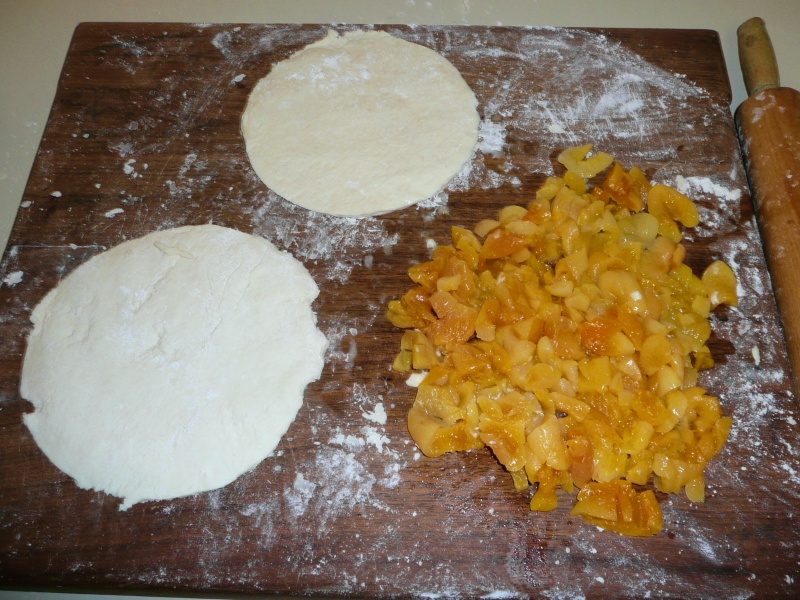
*The actual fruit was normally dried apples or peaches which had been reconstituted, but you can use canned fruit as well as long as it isn’t too “juicy”. In truth, almost any type of dried fruit which has been brought back to softness through stewing in a sauce pan or soaking in water for several hours can be used. In fact, one of my favorite fried pies is made from apricots, something not grown in my native Smokies, and I’ve also used dried pears, figs, blueberries, and cherries in addition to apples and peaches. A mix of regular raisins and golden ones, or raisins with chopped pecans mixed in, likewise makes for some fine eating. Whatever fruit you choose (and you can try two or three different ones when producing a single batch of fried pies should you so desire), just add a couple of heaping tablespoons of it to one side of your pastry circle and then fold it over into the shape which gives fried pies their colloquial names–half moons or mule ears. Fold the pastry over and crimp the edges thoroughly using a fork.
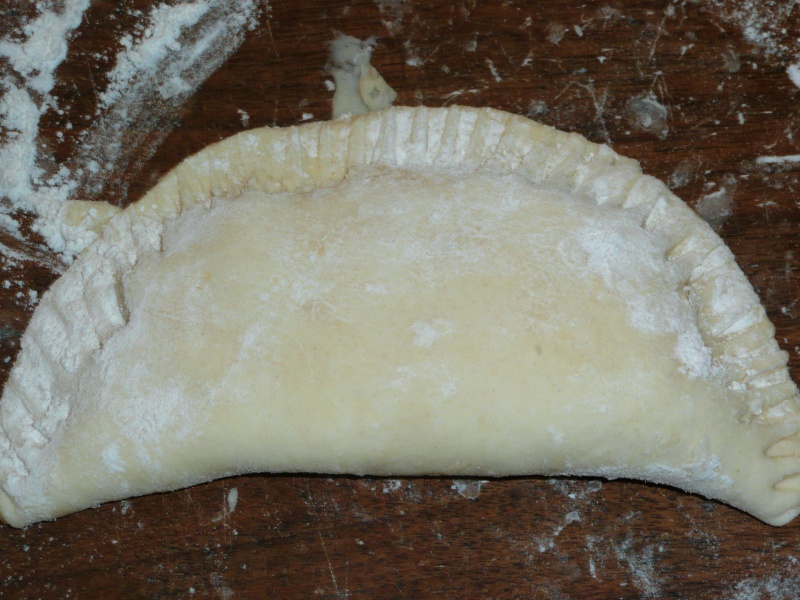
*You are now ready to fry the pies. This can be done in one of several ways. Perhaps the most straightforward approach is to heat lard or cooking oil. Grandma Minnie used lard but I guess today’s health-consciousness suggests leaning toward canola oil or something similar. Just heat the oil to a point where pies begin browning the moment they hit the frying pan (if the oil isn’t hot enough the pastry will soak up oil). Turn only once. An alternative, and it is one I actually prefer, is to fry the pies in melted butter. You’ve got to take more care with the heat level if you use butter, and after each batch of pies—I can do three at a time—you’ll likely need to add a bit more butter. Or you can fry the pies the way Momma often did, and her method involved almost no lard, oil, or butter. She would fry them atop a lightly greased pancake griddle.
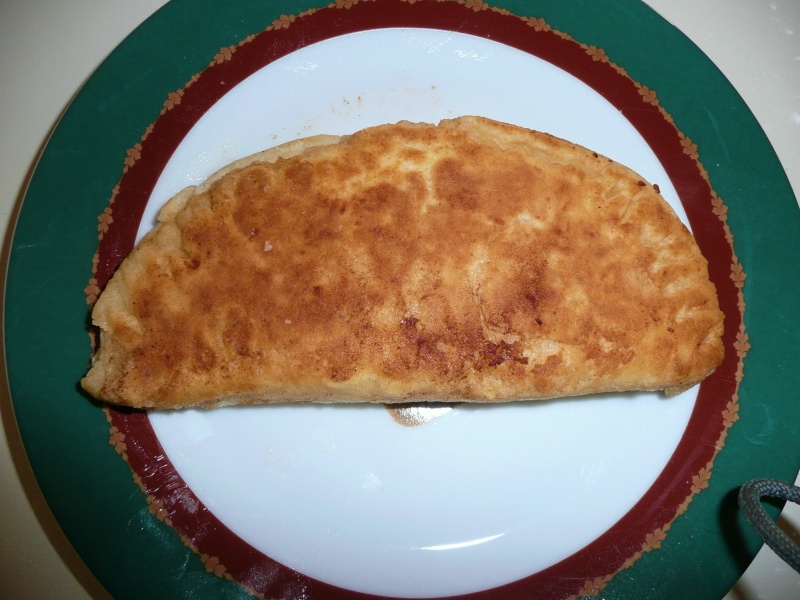
*However you choose to fry the pies, one final step remains after you remove them from the frying pan. Dust the pies with sugar, a cinnamon-sugar mix, or powdered sugar. They are ready to serve and are never better than when piping hot, although mere memories of a couple of cold fried pies tucked away in my old Duxbak hunting coat when I set out on a boyhood foray can still warms the cockles of my heart.
TRADITIONAL MOUNTAIN CORNBREAD
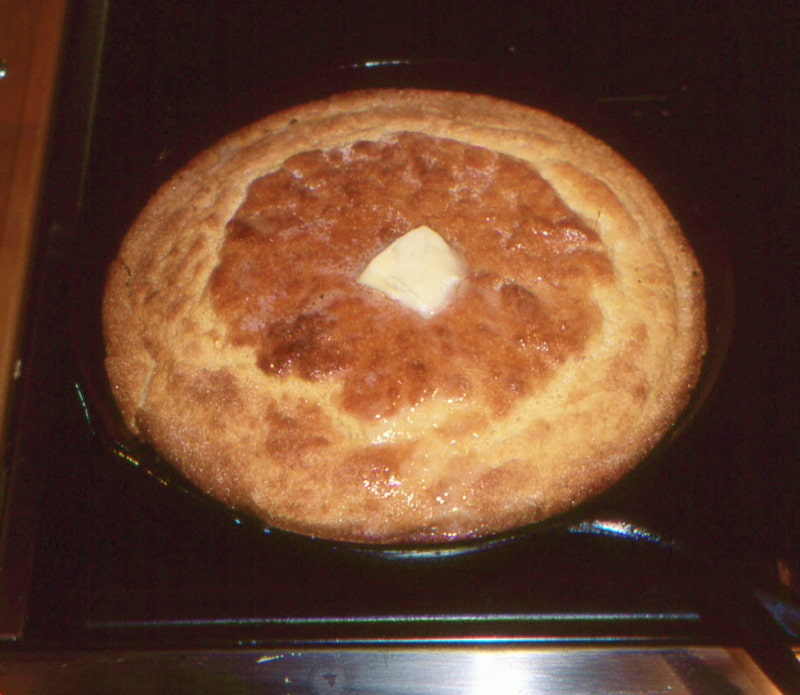
The keys to making really good cornbread are: (1) Cook it in a well-greased cast iron skillet, (2) Grease the skillet with streaked meat or bacon, (3) Use stone-ground cornmeal, and (4) Include the right ingredients. Most store-bought cornmeal has been ground at too high a temperature and this does something to the flavor. Also, stone-ground cornmeal, even if it is sifted, has more body or “crunch” to it, and I like that. If you don’t, sifting will solve the issue. Buttermilk, eggs, and lard are essential if you want really moist cornbread. This simple recipe has served me and my family well for as far back as my memory stretches, and I know Grandma Minnie was preparing it this way, though she never measured anything, around or possibly even before the turn of the 20th century.
2 cups cornmeal (white or yellow corn, although I think the best meal comes from a white field
corn such as Hickory King)
1 cup buttermilk
½ teaspoon baking soda
1 teaspoon salt
1 beaten egg
3 tablespoons grease from streaked meat
Prepare skillet in advance (using the streaked meat you cook to get grease). Mix the buttermilk, salt, baking soda and egg with cornmeal and stir thoroughly. Pour streaked meat grease into the batter and stir in well. Pour batter into pre-heated skillet and bake at 425 degrees for a half hour or until the top crust is golden brown. The bottom crust should be dark brown and the whole pone perfect for crumbling up in a bowl of pot likker. You can sop with cornbread if you wish, but for the ideal marriage of pot likker and cornpone, a big soup bowl is the way to go.
NOTE: If you like your cornbread especially moist, the addition of a double dollop of mayonnaise to the recipe above will do the trick. That of course raises the question of how much a dollop is. I would equate it to a heaping tablespoon so a double dollop would be two and a half tablespoons or thereabouts. Incidentally, a great deal of my cooking experience, and much of the approach Grandma Minnie, Momma, and my late wife Ann utilized involved words such as dollop, pinch, touch, or smidgen rather than precise measurements.
*******************************************************************************
CRACKLIN’ CORNBREAD
1 pint cracklin’s
1 quart slow ground cornmeal
1 pint buttermilk
1 teaspoon baking soda
Generous pinch of salt
Use a rolling pin to crush the cracklin’s into small bits. Make dough of cornmeal, buttermilk, baking soda, and salt. Heat the cracklin’s in a frying pan and then stir them into the dough, which should be fairly stiff. Shape into small cakes or bake the entire batch of batter in a well-greased pan. TIP: Heat the cracklin’s in the pan you plan to use to bake the bread. They will ensure it is nicely greased. Cook at 375 degrees until golden brown.
CORNBREAD DRESSING
Make cornbread using the “Traditional Mountain Cornbread” recipe above. Save broth from a baked turkey or chicken (or use purchased broth) and to it added finely chopped celery and onions, chopped pecans or chopped, boiled chestnuts (the latter have long been traditional in my family), and your choice of spices. I like a lot of black pepper and do not use sage, but many folks enjoy the special taste or tang sage imparts. Use a blender to turn your cornbread into crumbs. Add enough broth, with the other ingredients mixed in, to make a batter of about the same consistency as cornmeal batter. Pour batter into a baking pan and bake at 350 degrees until the top browns and a toothpick inserted in the dressing comes away clean. The dressing should still be moist, although if it gets a bit dry the answer is to adorn it with gravy.
SAWMILL GRAVY
In my lexicon the term “sawmill gravy” is in truth a sort of catch-all description. It can be applied to milk gravy made with a bacon grease base which then has cornmeal stirred in instead of flour, to pretty much any type of gravy where corn meal is used to make the roux in place of flour, or to the true gravy as it was typically served to loggers (in my experience a logging camp, as opposed to a sawmill, was much more likely to be the location for a sizeable group of semi-migratory workers). Of course some major logging operations had sawmills associated with them. True sawmill gravy involved a cornmeal, lard, and water mix. It might have been skimpy on costly ingredients (but then that was the idea) but was long on texture and stretched a moderate amount of cornmeal a “fur piece.”